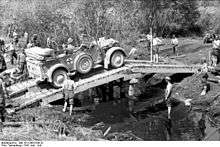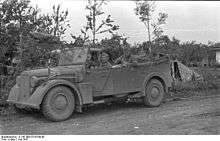Einheits-PKW der Wehrmacht
Einheits-PKW (German for 'standard passenger cars') were supplied to the Wehrmacht between 1936 and 1943 in the three versions Leichter Einheits-PKW, Mittlerer Einheits-PKW and Schwerer Einheits-PKW (light, medium and heavy passenger car). These vehicles were supposed to replace the civilian vehicles previously procured by the Reichswehr with cross-country mobile vehicles that conformed with military requirements while simplifying logistics and maintenance by using standardized components. The program achieved neither of these goals.
Specifications
| Einheits-Pkw der Wehrmacht | |||
|---|---|---|---|
| Light (le.E.Pkw) | Medium (m.E.Pkw) | Heavy (s.E.Pkw) | |
| Manufacturers: | Stoewer, BMW, Hanomag | Auto Union, Opel | Auto Union, Ford |
| Production period: | 1936 - 1942 | 1937 - 1943 | 1938 - 1941 |
| Specifications | |||
| Length: | 390 cm (12.8 ft) | 470 cm (15.4 ft) | 484 cm (15.88 ft) |
| Width: | 169 cm (5.54 ft) | 186 cm (6.10 ft) | 200 cm (6.6 ft) |
| Height: | 190 cm (6.2 ft) | 207 cm (6.79 ft) | 204 cm (6.69 ft) |
| Maximum weight: | 2.2t | 3.0t | 4.0t |
| Payload: | 500 kg (1,100 lb) | 600 kg (1,300 lb) (Funkwagen radio car: 980 kg (2,160 lb)) | 1,000 kg (2,200 lb) (Type 40 1,100 kg (2,400 lb)) |
| Ground clearance: | 23.5 cm (9.3 in) | 24 cm (9.4 in) | 25 cm (9.8 in) |
| Track width: | 140 cm (55 in) | 140 cm (55 in) | 160 cm (63 in) |
| Wheelbase: | 240 cm (94 in) | 300 cm (120 in) | 280 cm (110 in) |
| Engine: | Stoewer "AW 2" 4-cyl. petrol, 48 PS (47 hp) - 50 PS (49 hp) | Horch "830" 3.5L 8-cyl. petrol, 80 PS (79 hp) | |
| Alternative engine: | Stoewer "R 180W" 4-cyl. petrol, 42 PS (41 hp) - 43 PS (42 hp) | Horch V-8 3,8L 8-cyl. petrol, 90 PS (89 hp) | |
| Alternative engine: | BMW-"325" 6-cyl. petrol, 45 PS (44 hp) | Opel R-6 3,6L 6-cyl. petrol, 68 PS (67 hp) | Ford V-8 3,6L 8-cyl. petrol, 78 PS (77 hp) |
| Alternative engine: | Hanomag "20 B" 6-cyl. petrol, 48 PS (47 hp) - 50 PS (49 hp) | ||
| Range: | 400 km (250 mi) | 400 km (250 mi) | |
History
Early on in the process of motorizing, first the Reichswehr and then the Wehrmacht had procured militarized versions of many different makes and models of civilian passenger cars. Therefore, the Wehrmacht's inventory of passenger cars was unsatisfactory in a number of respects when the open re-armament began in 1935. On the one hand, the existing vehicles' cross-country mobility and durability were not up to military requirements. On the other, their maintenance and parts supply were highly complex due to the large number of different makes, models, and often even model generations.
After the Nazi takeover of power, increased funding became available for mechanization, and in 1934, a development program for standardized chassis was launched. It strove to achieve maximum cross-country mobility and extensive standardization of parts while employing the latest innovations in automotive engineering so the vehicles could be produced over a long period of time without many changes. Five types were initially planned:
- Leichter geländegängiger Personenkraftwagen (le. gl. Pkw, light off-road passenger car)
- Mittelschwerer geländegängiger Personenkraftwagen (m. gl. Pkw, medium off-road passenger car)
- Schwerer geländegängiger Personenkraftwagen (s. gl. Pkw, heavy off-road passenger car)
- Leichter geländegängiger Lastkraftwagen (le. gl. Lkw. light off-road truck)
- Mittelschwerer geländegängiger Lastkraftwagen (m. gl. Lkw, medium off-road truck)
Among other features, all types were required to have four-wheel drive, have independent suspension, and use domestic raw materials as stipulated by the Four Year Plan. However, due to the limitations of the German automotive industry at the time, the desired standardization was compromised right from the start. No single manufacturer was able to supply the required number of cars on its own. Several manufacturers were therefore charged with production, each supposedly following the same standardized plans: BMW (Werk Eisenach), Hanomag, Stoewer, Opel (Werk Brandenburg), Ford Germany and Auto Union (Horch and Wanderer). However, these companies in turn outsourced production of a large fraction of the individual components to different third-party suppliers. Also, each used engines from its own line-up of civilian models, so engines were not standardized from the outset.
The chassis of the heavy off-road passenger car was also used for the Leichter Panzerspähwagen (Sd.Kfz. 221 and Sd.Kfz. 222), although its engine was mounted in the rear.
The first light off-road passenger cars were delivered by Stoewer in 1936 (R 180 Spezial), followed in 1937 by the first medium and in 1938 by the first heavy models. The weaknesses of the program quickly became obvious - high costs, complex production and overstrained manufacturers unable to supply sufficient numbers of vehicles to fill all the slots of the receiving military units as planned. The Wehrmacht therefore still had to source 60% of their requirements elsewhere - converting regular civilian cars to military use, euphemistically terming them "Ergänzungsfahrzeuge" (supplementary vehicles), as well as employing requisitioned and captured civilian cars. This in turn led to many disadvantages with maintenance, supply and training.
Enquiries with the different branches of the military revealed that the Einheits-Pkw were also flawed designs largely unfit for wartime service. Not even the simplifications implemented on bodies and chassis in 1940 ("Typ 40", without the complex four-wheel steering, among others) failed to remedy the multitude of shortcomings. Their complex designs and excessive wear and tear aside, all types were mainly criticized for their high weight, which in turn meant a high fuel consumption and led to many broken frames and suspensions in the field. Accordingly, production of the three types ceased in 1942, 1943 and 1941, respectively.
Types

Leichter geländegängiger PKW
The light off-road passenger car was built by the BMW-Werk Eisenach under the designation BMW 325, as well as Hanomag (Typ 20 B) and Stoewer (Typ R 180 Spezial). The vehicles were used as troop carriers (Kfz. 1), by repair-and-maintenance squads (Kfz. 2/40), by artillery reconnaissance sonic measurement squads (Kfz. 3) and by troop-level aerial defense (Kfz. 4). Almost 13,000 units were built. Between 1940 and 1943, only Stoewer continued to build the R 200 Spezial without the four-wheel steering (Typ 40). The cars weighed 1,775 kg empty (1,700 kg without the four-wheel steering). 90% of all military branches rejected the vehicle as "unfit for wartime service" in a 1942 enquiry, while the much simpler, lighter and cheaper Volkswagen Kübelwagen proved to be far superior in basically every respect.


Mittelschwerer geländegängiger PKW
The medium off-road passenger car was built by the Opelwerk Brandenburg (chassis only) and Auto Union: Siegmar factory (former Wanderer) in Siegmar-Schönau (today a part of Chemnitz) and Horch factory in Zwickau. The Wehrmacht used them as troop transports (Kfz. 11, with tow bar: Kfz. 12, 6-seat version: Kfz. 21), in the signals corps (Kfz. 15, Kfz. 17, Kfz. 17/1) and for artillery reconnaissance (Kfz. 16 and Kfz. 16/1). Some 12,000 units were built. The most conspicuous change of the 1940 design simplification was the elimination of the mid-mounted spare wheels which simplified the bodywork and gave more interior space. The cars had a Horch V8 (Opel: in-line 6-cylinder) and a curb weight of 2,700 kg (open-topped Horch version: 3,080 kg) and was the only type that did not even initially have four-wheel steering. 80% of military branches rejected the vehicle as unfit for wartime service.

Schwerer geländegängiger PKW
The heavy off-road passenger car was built by Horch in Zwickau and Ford Germany in Cologne, each using their own V8 engines. They were used by the signals corps (Kfz. 23 and 24), as ambulances (Kfz. 31), as tractors for light artillery (Kfz. 69) and AA guns (Kfz. 81), as troop carriers (Kfz. 70) and as a carrier of AA searchlights (Kfz. 83). Furthermore, the armoured troop carrier Sd.Kfz. 247 and the rear-engined Leichter Panzerspähwagen armoured car in all its versions used the same chassis. Nearly 5,000 units were built in total. The cars had an empty weight of 3,300 kg (without four-wheel steering: 3,200 kg). Like the others, the heavy type lost the four-wheel steering along with the mid-mounted spare wheels in 1940. Although it suffered from the same deficiencies initially mentioned, as well as a heavy steering, it appears to have been the most successful type of the standardized off-road passenger car program.
Bibliography
- Spielberger J., Walter: Armored Vehicles of the German Army 1905–1945 (The Spielberger German Armour and Military Vehicle Series)
- Oswald, Werner: Kraftfahrzeuge und Panzer der Reichswehr, Wehrmacht und Bundeswehr. Motorbuch Verlag, Stuttgart, 17. Auflage 2004, ISBN 3-613-02370-9
- Vorschrift D 662/4 Einheitsfahrgestell I für leichten Personenkraftwagen Typ 40, Gerätebeschreibung und Bedienungsanweisung, Berlin 1941